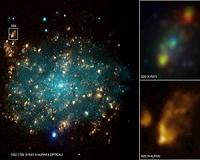 |
Boston MA (SPX) Jul 23, 2010 Scientists have found evidence that a giant black hole has been jerked around twice, causing its spin axis to point in a different direction from before. This discovery, made with new data from NASA's Chandra X-ray Observatory, might explain several mysterious-looking objects found throughout the Universe. The axis of the spinning black hole is thought to have moved, but not the black hole itself, so this result differs from recently published work on recoiling black holes. "We think this is the best evidence ever seen for a black hole having been jerked around like this," said Edmund Hodges-Kluck of the University of Maryland. "We're not exactly sure what caused this behavior, but it was probably triggered by a collision between two galaxies." A team of astronomers used Chandra for a long observation of a galaxy known as 4C+00.58, which is located about 780 million light years from Earth. Like most galaxies, 4C+00.58 contains a supermassive black hole at its center, but this one is actively pulling in copious quantities of gas. Gas swirling toward the black hole forms a disk around the black hole. Twisted magnetic fields in the disk generate strong electromagnetic forces that propel some of the gas away from the disk at high speed, producing radio jets. A radio image of this galaxy shows a bright pair of jets pointing from left to right and a fainter, more distant line of radio emission running in a different direction. More specifically, 4C+00.58 belongs to a class of "X-shaped" galaxies, so called because of the outline of their radio emission. The new Chandra data have allowed astronomers to determine what may be happening in this system, and perhaps in others like it. The X-ray image reveals four different cavities around the black hole. These cavities come in pairs: one in the top-right and bottom-left, and another in the top-left and bottom-right. When combined with the orientation of the radio jets, the complicated geometry revealed in the Chandra image may tell the story of what happened to this supermassive black hole and the galaxy it inhabits. "We think that this black hole has quite a history," said Christopher Reynolds of the University of Maryland in College Park. "Not once, but twice, something has caused this black hole to change its spin axis." According to the scenario presented by Hodges-Kluck and his colleagues, the spin axis of the black hole ran along a diagonal line from top-right to bottom-left. After a collision with a smaller galaxy, a jet powered by the black hole ignited, blowing away gas to form cavities in the hot gas to the top-right and bottom-left. Since the gas falling onto the black hole was not aligned with the spin of the black hole, the spin axis of the black hole rapidly changed direction, and the jets then pointed in a roughly top-left to bottom-right direction, creating cavities in the hot gas and radio emission in this direction. Then, either a merging of the two central black holes from the colliding galaxies, or more gas falling onto the black hole caused the spin axis to jerk around to its present direction in roughly a left to right direction. These types of changes in the angle of the spin of a supermassive black hole have previously been suggested to explain X-shaped radio galaxies, but no convincing case has been made in any individual case. "If we're right, our work shows that jets and cavities are like cosmic fossils that help trace the merger history of an active supermassive black hole and the galaxy it lives in," said Hodges-Kluck. "If even a fraction of X-shaped radio galaxies are produced by such "spin-flips", then their frequency may be important for estimating the detection rates with gravitational radiation missions."
Share This Article With Planet Earth
Related Links Chandra Understanding Time and Space
 Black Hole Blows Big Bubble
Black Hole Blows Big BubbleBoston MA (SPX) Jul 13, 2010 This composite image shows a powerful microquasar produced by a black hole in the outskirts of the nearby (12.7 million light years) galaxy NGC 7793. The large image contains data from the Chandra X-ray Observatory in red, green and blue, optical data from the Very Large Telescope in light blue, and optical emission by hydrogen ("H-alpha") from the CTIO 1.5-m telescope in gold. The upper i ... read more |
|
| The content herein, unless otherwise known to be public domain, are Copyright 1995-2010 - SpaceDaily. AFP and UPI Wire Stories are copyright Agence France-Presse and United Press International. ESA Portal Reports are copyright European Space Agency. All NASA sourced material is public domain. Additional copyrights may apply in whole or part to other bona fide parties. Advertising does not imply endorsement,agreement or approval of any opinions, statements or information provided by SpaceDaily on any Web page published or hosted by SpaceDaily. Privacy Statement |